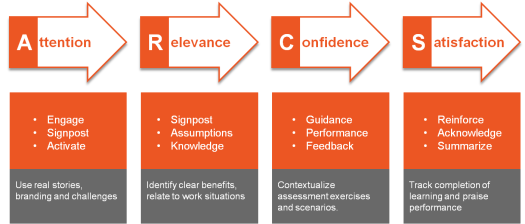In my previous blogs of the ADDIE series, I have shared with you an overview of the ADDIE model, explored the Analysis and the Design stages of the ADDIE model, and took a look at the Development phase. As this exciting journey comes to an end, in this last blog post I will go over the importance of authentic assessments and review the Implementation phase in the ADDIE model.
 Assessments are key players in the learning process as they help measure the effectiveness of the instructional event (Hodell, 2011). Authentic assessments differ from traditional assessment methods in that they provide the learner with an evaluation experience that closely mirrors real world situations (Myers, 2015). When authentic assessments are used, learners tend to be more engaged in the activities or exercises due to perceiving the tasks as being relevant beyond the classroom walls (Myers, 2015). Instructional designers are tasked with the challenge of ensuring that their design maintains the learner engaged and motivated for the duration of the learning process (Kearney &Perkins, 2014). To assist with this task, the ARCS model has proven to be a valuable and effective tool in every instructional designer’s tool box (Malik, 2014). The four components of the ARCS model are Attention, Relevance, Confidence, and Satisfaction, which have been found to highly influence human motivation (Malik, 2014).
Assessments are key players in the learning process as they help measure the effectiveness of the instructional event (Hodell, 2011). Authentic assessments differ from traditional assessment methods in that they provide the learner with an evaluation experience that closely mirrors real world situations (Myers, 2015). When authentic assessments are used, learners tend to be more engaged in the activities or exercises due to perceiving the tasks as being relevant beyond the classroom walls (Myers, 2015). Instructional designers are tasked with the challenge of ensuring that their design maintains the learner engaged and motivated for the duration of the learning process (Kearney &Perkins, 2014). To assist with this task, the ARCS model has proven to be a valuable and effective tool in every instructional designer’s tool box (Malik, 2014). The four components of the ARCS model are Attention, Relevance, Confidence, and Satisfaction, which have been found to highly influence human motivation (Malik, 2014).
Let’s take a look at the Implementation phase in the ADDIE model. This is the moment where the audience finally gets to interface with the instructional event (Hodell, 2011). As previously mentioned, evaluation is an important activity in every stage of the ADDIE model. Hodell (2011) discusses Kirkpatrick’s level of evaluation, and how level 1 and level 2 directly applies to the Implementation phase. Evaluating what the learners thought of the instructional event is connected to Kirkpatrick’s level 1 evaluation: reaction (Hodell, 2011). Evaluating if the learner actually met the intended learning outcomes of the instructional event connects to Kirkpatrick’s level 2 evaluation: learning (Hodell, 2011). . Continuous evaluation of the instructional event helps instructional designers identify areas that need improvement, keeping the instructional event evolving even after it has been implemented (Hodell, 2011). Below is a fantastic video presenting an overview of Kirkpatrick’s level of evaluation model.
Exploring authentic assessments and how they are different from traditional assessments has transformed the way I think about measuring true learning, making a significant impact in my future practice as an instructional designer. Growing up in the era of fill-in-the-blanks and multiple choice, I never thought of them as evaluation tools that do not truly measure valuable skills that can be transferred into the real world. I find this to be a positive realization, making me aware of how much teaching and learning has changed in recent years. More importantly, how these changes benefit the learner in profound ways. As an aspiring instructional designer, learning the importance of differentiating the type of knowledge that reflects actual learning, and the type of skills that truly demonstrate mastery of the learning objectives will influence the way I will incorporate assessments when designing instruction in the future. Assessments are indispensable to learning, making them as authentic as possible will not only help me keep learners motivated, but it will also help learners fortify their foundation to be successful individuals beyond the classroom setting.
References
Hodell, C. (2011). Isd from the ground up: A no-nonsense approach to instructional design (3rd ed.). United States of America: American Society for Training & Development.
Kearney, S. s., & Perkins, T. t. (2014). Engaging students through assessment: the success and limitations of the aspal (authentic self and peer assessment for learning) model. Journal Of University Teaching & Learning Practice, 11(3), 1-14.
Malik, S. S. (2014). Effectiveness of arcs model of motivational design to overcome non completion rate of students in distance education. Turkish Online Journal Of Distance Education (TOJDE), 15(2), 194-200.
Myers, S. (2015). Authentic Assessment. Authentic Assessment — Research Starters Education, 1.

